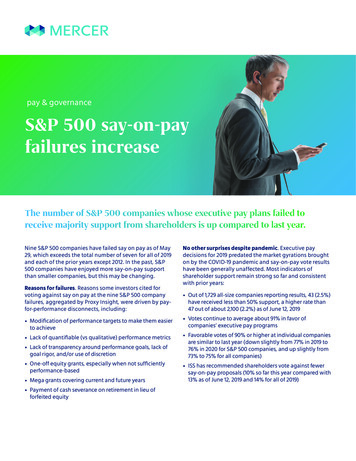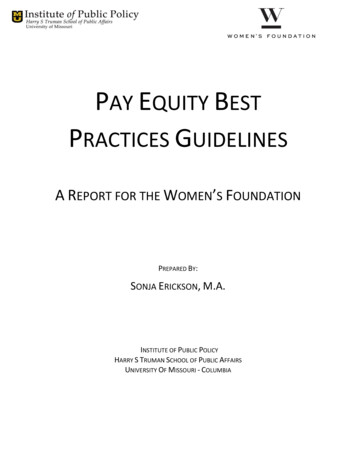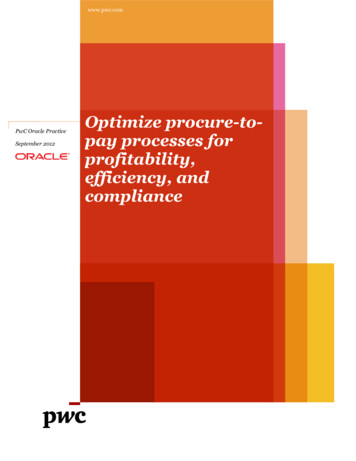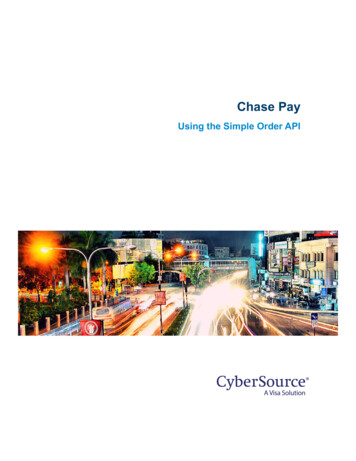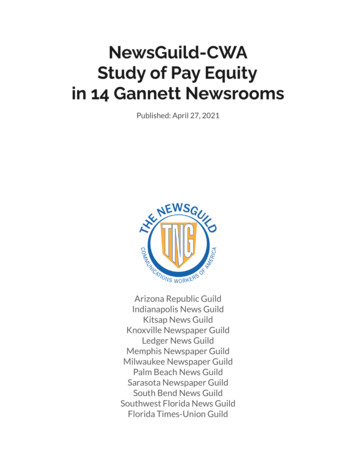
Transcription
NewsGuild-CWAStudy of Pay Equityin 14 Gannett NewsroomsPublished: April 27, 2021Arizona Republic GuildIndianapolis News GuildKitsap News GuildKnoxville Newspaper GuildLedger News GuildMemphis Newspaper GuildMilwaukee Newspaper GuildPalm Beach News GuildSarasota Newspaper GuildSouth Bend News GuildSouthwest Florida News GuildFlorida Times-Union Guild
Table of contentsKey findingsPurpose of this studyOur recommendations to GannettWho is included in this sWhite men make up nearly half of Gannett workforceMost newspapers are male-dominatedGannett employees are overwhelmingly whiteNewsrooms are less racially diverse than the nationNewsrooms are less racially diverse than the communities they serveVeteran female journalists are rareVeteran journalists of color are rareGannett median salary is 13,000 below U.S. rate for college-educated workersWomen earn 9,845 less than menNon-white employees earn 5,246 less than white employeesNon-white women earn 15,727 less than white menOlder women earn 6,642 less than older menWomen who work at Gannett the longest earn 27,026 less than menSome middle-aged journalists of color earn 6,976 less than white peersSome experienced people of color earn 4,685 less than white peersThe Arizona Republic has the largest gender pay gapThe gender pay gap at The Arizona Republic is nearly 30,000The Arizona Republic has the largest racial pay gapThe racial pay gap at The Arizona Republic is more than 25,000Unionizing lessens gender and racial pay gapsPay gaps in Milwaukee illustrate need for guaranteed pay scalesTestimonialsGannett employees in their own words8910111213141516171819202122232425262728292
Key findingsOur analysis of salaries in 14 newsrooms at Gannett, the largest newspapercompany in the U.S., found pay disparities among women and people of color, aswell as a dearth of diversity, in nearly every location that participated.We also found unions made a difference. Units with pay scales in their contractshad smaller gender and racial pay gaps than units bargaining their first contracts.Our key findings: Women who worked at least 30 years at newspapers currently owned byGannett earned 27,026 less, or 63% the annual median salary of male peers. Women of color earned 15,727 less, or 73% of white men’s median salary. Women earned 9,845 less, or 83% of men's median salary. Women 50-60 years old earned 6,642 less, or 90% the median salary of menin the same age range. The gap grew to 10,677 when including part-timers. Journalists of color earned 5,246 less, or 90% of the white median salary. Experienced female journalists and journalists of color were rare. Menoutnumbered women age 30 and above, or with at least 10 years at thecompany, by about 2 to 1. White journalists outnumbered journalists of colorage 40 and above, or with at least 10 years of service, by more than 4 to 1. Thirteen of 14 newsrooms were whiter than the communities they covered.Only the Knoxville News Sentinel was more diverse than its county. The Arizona Republic was the most diverse newsroom but had the largestgender and racial pay gaps. Women made nearly 30,000 less in median wagesthan men. People of color earned about 25,000 less in median wages thanwhite employees. Unionizing improves pay equity. Newsrooms with union contracts had agender pay gap that was 6,846 smaller and a racial pay gap that was 5,443smaller than newsrooms currently negotiating first contracts.Purpose of this studyMembers of the NewsGuild, an international union of journalists, have led the wayin calling for fair pay in the media industry.Guilds at the New York Times, Washington Post, Los Angeles Times, Wall StreetJournal, Philadelphia Inquirer, San Francisco Chronicle and others have found paygaps of thousands of dollars. Guild members have successfully advocated for3
overall raises, individual raises, diverse hiring and more.This is the first time, to our knowledge, a pay equity study has been released formultiple newsrooms across Gannett.Gannett pledged in 2020 to hire and promote more women and employees of colorto reflect national and local demographics.In 2021, a company report found Gannett’s executive team was 84% white and73% male, while its newsrooms were 58% male and 79% white. (Similarly, our studyof 14 newsrooms found 59% of employees were male and 78% were white.)The company announced “inclusion, diversity and equity are core to our business,”and all employees should have “equal opportunities to thrive.”“(W)e are committed to driving positive change. While this will, at times, meanaddressing and combating systemic barriers and having uncomfortableconversations, we believe silence is not an option. We want to become a leadernot just in what we do, but who we are as a company,” CEO Mike Reed said.However, neither report promised to ensure fair pay or correct pay gaps, key partsof attracting and retaining talent. And though the company touted its commitmentto transparency, Gannett has not publicly released a pay equity study.We believe our 14 newsrooms are not outliers but examples of the problems with,and potential solutions to, pay equity across Gannett.Our recommendations to GannettIn response to this study, we call on Gannett to: Release anonymized pay data for the entire company, broken down bylocation, department, job title, years at the company, age, gender and race.Additional data, such as sexual orientation, military service, educationalattainment or religion, is welcome.Take swift action to eliminate pay disparities, including back pay.Raise the starting salary to a living wage and implement pay scales based onexperience companywide.Create policies and ongoing reviews to improve hiring and retention of peoplefrom underrepresented groups, as well as to eliminate future pay disparities.Voluntarily recognize and bargain in good faith with employees that unionize.4
Who is included in this study?Fourteen unionized newsrooms requested salary and demographic data fromGannett in fall 2020 as governed by U.S. labor law.The anonymized data comprised 466 non-management employees (441 full-timeand 25 part-time*). The company did not provide data for managers. The studyconclusions and graphics refer to full-time employees, unless specified.The newsrooms that participated in the study were: The Arizona RepublicIndianapolis StarFlorida Times-UnionFt. Myers News-Press and Naples Daily News (combined)Kitsap SunKnoxville News SentinelLakeland LedgerMemphis Commercial AppealMilwaukee Journal SentinelPalm Beach Post and Palm Beach Daily News (combined)Sarasota Herald-TribuneSouth Bend Tribune5
MethodologyAnonymization: Names were removed from the data before it was analyzed and insome cases before it was received. Six reporters securely accessed the data.Binning: All charts that include binned numbers, such as 10-20 and 20-30, actuallyreflect a 0 to 9 format. That means 10-20 is actually 10-19 and 20-30 is 20-29, etc.Colors: Orange and teal graphics typically signify gender. Purple is typically race.Data collection: Fourteen NewsGuild bargaining units requested and receivedsalary data from Gannett in fall 2020 under U.S. labor law. The data includednewsroom workers’ pay, age, gender, race, years at Gannett and job title.Geography: The study includes employees from newsrooms throughout the U.S.,including the South, Midwest, Southwest and Northwest.Journalists included only: This analysis is limited to non-management journalistssuch as reporters, photographers, producers and columnists. The data representedtoo few non-newsroom employees to preserve anonymity. In most cases, part-timeemployees were excluded for the same reason. When they are included, thegraphics specify.Median vs. average: We used median pay instead of average to more accuratelyreflect the range of salaries in a workplace. The median is the midpoint betweenthe higher paid half of employees and the lower paid half. Average, on the otherhand, can obscure the middle range of salaries when an extreme high or extremelow salary swings the calculation.Regression: We used the R programming language to see what factors influencednewsroom workers’ pay. We used multiple regression analysis, a statistical methodthat allowed us to see how a worker’s pay is related to their race, ethnicity, age,years working at Gannett, the newsroom they worked for, and whether thatnewsroom has a union contract — all at the same time.Standardization: During the analysis, we compared hourly and salaried workers’annual pay rates. Job titles were also standardized.Size of each unit: The number of employees represented by the NewsGuild in eachnewsroom ranged from 93 to 9. The size of each newsroom should be taken intoaccount. One employee’s pay and demographics can impact the analysis more in a6
smaller unit than in a larger unit.*Years of Service and Age: Calculations that aggregate employees based on yearsof service include 440 full-time employees, because years of service data for 1employee was missing. Calculations that aggregate employees based on ageinclude 432 full-time employees, because age data for 9 employees was missing.ContributorsThe NewsGuild’s Gannett Caucus, made up of 41 unionized newspapers across thecompany, recruited highly qualified member volunteers to conduct this study: Emily Hopkins, data reporter, Indianapolis Star Andrew Mollica, newsroom developer, Milwaukee Journal Sentinel Andrew Pantazi, data reporter, formerly Florida Times-Union Christopher Persaud, data reporter, Palm Beach Post Justin Price, data reporter, The Arizona Republic Rebekah Sanders, consumer reporter, The Arizona RepublicContactQuestions? Want to share your story? Ready to help make change?Contact Rebekah Sanders at Rebekah.L.Sanders@gmail.com.7
White men make up nearly half ofGannett workforceEmployees in the study were overwhelmingly white and male. About 78% ofemployees were white, while 59% were men. Nearly half were white men.8
Most newspapers aremale-dominatedWhen looking at individual newspapers, most employed more men than women.The Arizona Republic had a nearly even split. The Knoxville News Sentinelemployed more women than men.9
Gannett employees areoverwhelmingly whiteThe journalists in the study were less racially diverse than the U.S. as a whole.Nearly 78% of workers in the 14 newsrooms were non-Hispanic white. Theremaining employees self-identified as 8.6% Hispanic, 6.4% Black, 3.4% Asian and3.8% other racial groups (Native, Arab, multiracial, other or unspecified).The U.S. is roughly 60% non-Hispanic white. The remaining population is about19% Hispanic, 13% Black, 6% Asian and 4% Native or multiracial, according to theU.S. Census Bureau.10
Newsrooms are less racially diversethan the nationThe largest newsroom, The Arizona Republic, was the most diverse newsroom,with 36% non-white staff. The smallest newsroom, the Kitsap Sun, with nineemployees, was the sole all-white newsroom.None of the newsrooms reflected national demographics. Roughly 40% of the U.S.is not white, according to U.S. Census estimates.11
Newsrooms are less racially diversethan the communities they serveThe Knoxville News Sentinel was unique among newsrooms for having a moreracially diverse staff than the county where it was located. All other Gannettnewsrooms were less racially diverse than their readers.The Florida Times-Union in Duval County was the least representative with 91% ofstaffers being white and the county being 52% white.12
Veteran female journalists are rareFemale journalists were typically younger than 30 and had worked fewer than 10years at newspapers owned by Gannett, suggesting problems with retaining them.Experienced women were rare. Men outnumbered women age 30 and above, orwith at least 10 years at the company, by about 2 to 1. (Years of service indicates how longan employee has worked at Gannett and predecessor companies, not total journalism experience.)13
Veteran journalists of color are rareMost journalists of color were younger than 40 or had worked fewer than 10 yearsat newspapers owned by Gannett, suggesting problems retaining them.Experienced employees of color were rare. White journalists outnumberedjournalists of color age 40 and above, or with at least 10 years of service, by morethan 4 to 1. (Years of service indicates how long an employee has worked at Gannett and predecessorcompanies, not total journalism experience.)14
Gannett median salary is 13,000below national rate forcollege-educated workersGannett journalists are typically required to be college-educated. The U.S. mediansalary for workers with a bachelor’s degree in 2019 was 64,896, according to theBureau of Labor Statistics. The median salary at Gannett newspapers in the studywas 52,000, or nearly 13,000 lower than the national median for degreedworkers.70% of journalists in the report earned below the U.S. median for college-educatedworkers. 1 in 5 earned below 40,000.15
Women earn 9,845 less than menWomen’s median full-time salary was 9,845 lower, or 83% what men earned, inthe newsrooms studied.Once part-timers were added, women made a median of 8,327 less than men.Part of the reason for the gap is likely that Gannett employs a large number ofyounger women, who typically earn lower salaries than the large number ofexperienced men employed by the company.However, even when controlling for age and experience, older and moreexperienced women still faced large pay disparities compared to men (see graphicson following pages).16
Non-white employees earn 5,246less than white employeesJournalists’ of color median full-time salary was 5,246 lower, or 90% what whitesearned, in the newsrooms studied.Once part-timers were added, journalists of color made a median 4,081 less thanwhite journalists.Part of the reason for the gap may be that Gannett employs more journalists ofcolor who are younger and earn lower salaries than the large number ofexperienced white journalists.However, even when controlling for age and experience, older and moreexperienced journalists of color still faced pay disparities compared to older andmore experienced white journalists (see graphics on following pages).17
Non-white women earn 15,727 lessthan white menWomen of all races earned less than men of all races, but non-white women wereworst off.Women of color earned a median salary 15,727 lower, or 73% what white menmade.18
Older women earn 6,642 less thanolder menWomen between ages 50-60 were most affected by the pay gap. They made amedian full-time salary 6,642 lower, or 90% of men of similar age. When addingpart-time workers, the gap worsened to 10,677.Countering the trend, women in their 20s and 30s exceeded the median pay ofmen, though by smaller amounts. For those in their 20s, women made 2,669 more.For women in their 30s, women made 761. (See page 28 for more explanation.)19
Women who work at company thelongest earn 27,026 less than menThe gender pay gap was largest among those with the longest tenure at Gannett,including newspapers acquired in the 2019 merger.Women who had worked 30 years at the company earned 27,026 less, or 63%the median salary of men with similar years of service. (Years of service indicates how longan employee has worked at Gannett and predecessor companies, not total journalism experience.)20
Some middle-age journalists of colorearn 6,976 less than white peersJournalists of color between ages 40-50 were most affected by the pay gap. Theymade a median salary 6,976 lower, or 88% of white employees in the age group.For those in their 20s, the median wage was 2,017 higher for white journalists.Countering the trend, employees of color over age 50 exceeded the median pay ofwhite employees by 3,076.21
Some experienced people of colorearn 4,685 less than white peersThe racial pay gap was largest among those with 10-20 years of service at Gannett,including newspapers acquired in the 2019 merger.Journalists of color with that tenure earned a median salary 4,685 less, or 92%what white journalists with similar years of service made.Countering the trend, employees of color who had served more than 20 years atGannett exceeded the median pay of white employees by 1,634.(Years of service indicates how long an employee has worked at Gannett and predecessor companies, nottotal journalism experience.)22
The Arizona Republic has the largestgender pay gapAll but two newsroomshad pay inequities forwomen.The largest gender paygap was at The ArizonaRepublic, wherewomen’s mediansalary was 61% ofmen’s median salary.The second largestwas at the Palm BeachPost/Daily News,where women made70% what men earned.Countering the trend,the median womanearned 8-11% morethan the median manat two small units, theLakeland Ledger andKitsap Sun.23
The gender pay gap at The ArizonaRepublic is nearly 30,000The gender pay gap in allbut two newsroomstotalled 1,700 to 29,700 more in earningsfor the median man thanthe median woman.The largest gap, at TheArizona Republic, costwomen nearly 30,000 inmedian yearly earnings.The second largest gap, atthe Palm Beach Post/DailyNews, cost women morethan 21,000 in medianyearly earnings.Countering the trend, themedian woman earned 3,800 to 5,200 morethan the median man attwo small units, theLakeland Ledger andKitsap Sun.24
The Arizona Republic has the largestracial pay gapMost newsrooms paid journalists of color 3% to 37% less than white employees.The largest racial pay gap was at The Arizona Republic, where median pay foremployees of color was 63% of white workers’. The next largest gap was at the PalmBeach Post/Daily News, where median pay for employees of color was 78% ofwhite workers’.Countering the trend, the Milwaukee Journal Sentinel’s median salary was lowerfor white journalists. They made 95% what employees of color earned.(Five newsrooms were excluded from the racial pay gap analysis to preserve anonymity because they hadfewer than 5 journalists of color.)25
The racial pay gap at The ArizonaRepublic is more than 25,000The racial pay gap totalled 1,600 to 25,100 more in earnings for whitejournalists than journalists of color.The largest gap, at The Arizona Republic, cost journalists of color 25,100 inmedian yearly earnings. The second largest gap, at the Palm Beach Post/DailyNews, cost journalists of color 14,500.Countering the trend, the median employee of color made 2,900 more than themedian white employee at the Milwaukee Journal Sentinel.26
Unionizinglessens genderand racial paygapsThe data shows that unionizinglessens gender and racial salaryinequities.We compared seven Gannettnewsrooms with longstandingunion contracts to seven recentlyunionized newsrooms negotiatingfirst union contracts.The gender pay gap was 7,676 innewsrooms with longstandingunion contracts compared to 14,522 in newsrooms currentlynegotiating first contracts.The racial pay gap was 837 innewsrooms with longstandingunion contracts compared to 6,280 in newsrooms currentlynegotiating first contracts.The effect is likely due in part tounion contracts that havetransparent pay scales that ensureemployees receive minimumsalaries according to level ofexperience rather thanmanagement whims, in addition tocost-of-living increases that allemployees receive rather than afavored few.27
Pay gaps for men in Milwaukeehighlight need for pay scalesThe Milwaukee Journal Sentinel newsroom, which has been unionized for morethan three decades, includes pay minimums based on experience for most workersin its contract. However, one department newly added to the bargaining unitremains without a pay scale.Our analysis shows journalists left out of the union pay scale were paid significantlyless compared to journalists covered by the union pay scale. And the disparities forthese journalists have worsened over time, as shown in the graphic below, as theymissed out on the union contract's guaranteed increases.Because of the significant disparities within the department, this group of largelymale journalists’ pay brings down the median salary for all men across Gannettnewsrooms in the study, but particularly those under 40 years old.The data demonstrates that union pay scales typically increase worker wages andreveals the need for Gannett to raise this department to a fair scale.28
Testimonials:Employees in their own wordsGannett employees explain the personal impact of pay inequity and lack ofdiversity at their newspapers and their support for change.Want to add your testimonial to this report? Email Rebekah.L.Sanders@gmail.com.“I remember the punched-in-the-gut feeling I had the moment I learned that ayoung male reporter with just a few years of experience had nearly the exact samesalary that I had, despite my two decades as a working journalist.I'm extremely proud of the work I've done, from breaking news to projects andinvestigations, but it's discouraging knowing that I make less money than manymen in the newsroom with the same or fewer years of experience. While I hope tohave a long career in journalism, and a long career at my paper, I worry thatcontinuing pay inequity will lead me to leave in search of higher-paying journalismjobs elsewhere — or drive me to simply change careers altogether.”— Milwaukee Journal Sentinel journalist“I viscerally remember the feeling of learning I was the lowest-paid reporter in mynewsroom, even after three years of working there, covering one of the busiestbeats and still carving out time for high-impact special projects. At that time, Ilearned I even was paid a lower hourly rate than a fellowship filled by a white manwith roughly the same level of experience I had. The Guild supported me in my fightfor more equitable pay with my peers and showed me how our contract couldstrengthen my case with management for a raise, which I ultimately achieved.Taking a stand then has put me in a much better position in the years since.Now, as I look to the future and this new data analyzed by the Guild's GannettCaucus, I am alarmed by the lack of mid-career female representation in ournewsrooms and the dismal retention of female reporting talent. I can't help butworry that I will become one of those vanishing statistics.”— Milwaukee Journal Sentinel journalist29
“For more than eight years, I've edited a section of the newspaper without an editortitle or commensurate pay — and for the record, I've asked for both. In addition toediting that section, plus other special sections throughout the year, I report andwrite for my section and others, edit colleague's work for other sections, and helpwith other digital projects and events.In one of those years, not only was I paid less than an editor, I was paid less thanour contract-negotiated rate for my position, based on my years of experience — asituation only rectified after the Guild brought it to management's attention.I'm thankful the Guild had my back and got me the back pay and raise that Ideserved, but I'm still frustrated that I'm paid less than other editors in mynewsroom. That includes a white male colleague who was promoted into an editorrole in my department despite not applying for or being qualified for that position.It was a position I had asked for and essentially was already doing, but had neverbeen given the chance to apply for.My experience is not unique. A nearly identical situation happened to a femalecolleague, and it led to her leaving our newsroom for another job. We are going tocontinue to lose talented employees if we continue to pay them less than they areworth while they see their white male colleagues making more. If we want toproduce the best journalism, we need to have the best people from a diversity ofbackgrounds, and we need to retain them by paying them what they are worth.”— Milwaukee Journal Sentinel journalist"I think it's criminal for Gannett or any other news organizations to have payinequity based on gender or color while these same organizations expose andcondemn other industries of doing the same. It's the typical do as I say, not as I do."— Sarasota Herald-Tribune journalist"I believe in equal pay and diversity because we need to be a workplace foreveryone."— Sarasota Herald-Tribune journalist30
“Gannett has pledged to hire a more diverse workforce but it should also work justas hard to retain and promote those employed now.Representation matters. It's important for young journalists of color and women tobe able to see themselves and find mentors in leadership roles for retention effortsto work.That's certainly not the case now as we keep seeing women and women of colorleaving leadership roles because Gannett keeps eliminating their positions, orbecause they don't get paid as much as their white counterparts. This leads to theirdeparture and in turn to the departure of younger journalists who are left withoutallies in our predominantly white newsrooms.”— Indianapolis Star journalist"We can’t tell the community we want to reflect them and then not create a placewhere journalists of color can thrive. Equal pay — and mentoring, continuingeducation, training opportunities, etc. — is critical if we want to recruit and RETAINjournalists of color. It’s not enough to get them to our newsroom. We have to createa welcoming space where their voices are heard and valued and give them the toolsand resources to be successful. Otherwise, it’s diversity for diversity’s sake, whichserves no one."— Indianapolis Star journalist"The best way to retain POC journalists is with fair pay and benefits, inclusivity innewsroom culture and decisions and opportunities to grow and move up."—Indianapolis Star journalist"Humans should have the right to be paid equally for comparable work andcertainly should not make less based on gender identity or race."— Indianapolis Star journalist31
"I believe, despite my nearly decade history in journalism, I am being paid at a baselevel. The company has done nothing to increase my salary."— Springfield News-Leader journalist“As a woman and as an experienced reporter, I have long felt undervalued by thevarious companies that owned the newspapers where I worked. So I was notsurprised at the pay disparities in the study. I will be surprised if those disparitiesare addressed by the time I retire, but because of increasing unionization I amhopeful younger generations of reporters will see their value better reflected intheir paychecks. Meanwhile, I will keep doing what I’m doing because I love thework, period.”— Florida Times-Union journalist"Last year, I learned that a male colleague who was hired after me and has lessnewsroom experience than me is being paid much more than I am. It hurt to learnthat, especially as everyone took on more work when COVID-19 hit. To know thathe is paid several more dollars an hour than me makes me feel as if my work is lessvaluable and my contributions are worth less than his.If diversity is truly important to Gannett, the company will make steps towardmore equitable pay. For us to have a newsroom that reflects the community wecover, equal pay is a must.”— Knoxville News Sentinel journalist“I was told pay is determined by experience when I asked for a raise, but I earnentry-level pay as a mid-career reporter. After over a decade in this industry I feelused. There is always an excuse when I ask to be paid equally to those with mysame experience level.Don't use my skin for your diversity. My skin made me work twice as hard to behere so I deserve to earn twice as much as you can afford. I could at least get even.”— Arizona Republic journalist32
"I was told my coworkers and I were going to be hired at the same rate, and that’swhy I couldn’t negotiate for more when accepting the position. That was awfullywrong, and a statement an editor said he did not recall making. Upon hiring,another coworker was immediately paid more than 8,000 more, and as timewent on — even with pay adjustments to reduce disparities — the discrepancy grewso large that what another peer made in four days, I had to work five to earn. Manypeople of color and women often get paid less, while organizations applaud theirown work in diversifying their staff. I’ve never seen pay disparity as bad as whileworking at The Republic."— Former Arizona Republic journalist“The pay inequity that I experienced during my time in the newsroom was prettymuch in plain sight the entire time. In 2018 and 2019, as a woman of color with abachelor’s degree, I wrote original content and was paid less than 15 an hour. Notonly were my male counterparts with similar background/experience getting paidmore, there were INTERNS in the newsroom paid a higher wage than I was.The low pay continued even after a merit-based promotion in 2020. My officialduties in the new position included THREE different jobs with an hourly wage thatdidn’t even properly compensate me for one of the jobs, let alone all three. Whenthe company had rounds of furloughs, I made less than the minimum amountrequired to participate. Sounds great, right? It’s not. This basically meant that I waspaid less than my counterparts.I was not alone. Other women of color were routinely put in a position where theyhad to accept getting paid less than their male and white counterparts – oftenwhile being asked to carry a heavier workload. It was either take the low pay orleave the job. You had to choose.”— Former Arizona Republic journalist"The company wanted to start me at a similar pay as new college graduates. Someof us journalists of color are in our 30s, yet we still can't catch up to some of ouryounger, white colleagues. And when we speak multiple languages, the companybenefits from our interviews and translations, but doesn't pay us for that benefit."— Arizona Republic journalist33
“After many title changes and added job responsibilities, all I get are excuses frommanageme
Gannett median salary is 13,000 below U.S. rate for college-educated workers 15 Women earn 9,845 less than men 16 Non-white employees earn 5,246 less than white employees 17 Non-white women earn 15,727 less than white men 18 Older women earn 6,642 less than older men 19 Women who work at Gannett the longest earn 27,026 less than men 20
